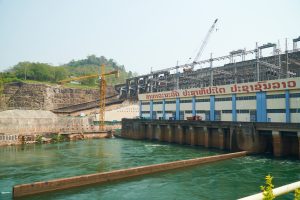What is happening at Électricité du Laos (EDL), Laos’ badly indebted state-run energy utility? Up until early 2021, it owned a three-quarters stake in the EDL-Generation Public Company (EDL-Gen), a publicly listed subsidiary. Created in 2010, as part of a drive by the government to improve the efficiency of its incompetently and debt-laden state-run enterprises, EDL-Gen took over most of its parent company’s energy generation assets and stakes in independent power producers, as well as subsequently building its own generation facilities. Basically, EDL-Gen generates and sells the electricity to EDL, which then sells it to domestic consumers. Still, up until 2021, EDL controlled a 75 percent stake in EDL-Gen.
However, in February 2021, EDL sold 24 percent of its shares to Phongsubthavy Group, specifically to a subsidiary, the Phongsubthavy Road-Bridge, Building and Irrigation Construction Sole Company. Phongsubthavy Group is a many-armed conglomerate with principal interests in construction and infrastructure development. Its owner and chairman, Phongsavath Senaphuan, is well-connected and up until this year sat on EDL-Gen’s board. He departed because, in February, Phongsubthavy Group transferred the same percentage of shares back to EDL. Why the flip-flop?
Phongsubthavy Group could have decided that holding EDL-Gen stock no longer made financial sense. In 2023, EDL-Gen made a net loss of around 1.09 trillion kip ($60 million) and there was no dividend payment for shareholders last year (because of the net loss), according to minutes of its annual general meeting in March. That said, EDL-Gen did make a profit of 2.1 trillion kip (around $140 million) in 2022. Moreover, EDL-Gen’s first-quarter report for this year states that basic earnings per share were 52 kip in March this year, compared with 35 kip in March 2023, which would suggest that Phongsubthavy Group’s sell-back wasn’t primarily business-orientated. Indeed, Viengsavanh Senaphuan, who I believe to be the wife of Phongsavath Senaphuan, still holds 1.5 percent of EDL-Gen’s shares.
Phongsubthavy Group could have been pressured to sell back the shares amid a high-level reshuffle within the Ministry of Energy and Mines that also took place in February. Vongsakoun Yingyong, managing director of the EDL-Gen, became the new director of EDL. Chanthaboun Soukaloun, EDL’s previous director, became deputy energy minister.
Because of the collapse of Laos’ currency in 2021, the sell-back was a good deal for EDL. When EDL-Gen was incorporated in December 2010, it had 2.6 trillion kip ($325 million at the exchange rate at the time) in registered capital, divided into 651 million shares at 4,000 kip per share (worth $0.50 at the time). I do not believe that EDL-Gen has increased the number of shares since Phongsubthavy Group bought out EDL’s stake in 2021. If each share was still priced at 4,000 kip, that would put the value of the sale in February at around 161 billion kip, which, because of the depreciation of the kip, was worth $8.9 million at the time. But when Phongsubthavy Group bought the 24 percent stake in 2021, before the kip had massively deteriorated, those shares would have been worth $17.3 million. Presumably, EDL could write up the $8.4 million difference as profit.
However, a rumor I hear from sources in Laos is that EDL might be preparing to sell a major stake in EDL-Gen to a Chinese bidder, expanding China’s interest in the energy network of its southern neighbor. In 2020, EDL and the China Southern Power Grid Company agreed to establish a new entity called Electricite du Laos Transmission Company (EDL-T) to develop the country’s power grid, principally its transmission lines, which badly needed an upgrade. The deal was highly controversial since EDL effectively sold its power transmission network to China Southern Power, the 90 percent shareholder of EDL-T, putting it in charge of how electricity is supplied domestically and internationally (EDL-T also handles connections to power grids in neighboring countries). EDL-T officially started its operations on January 29 this year, days before the EDL bought back its shares in EDL-Gen.
EDL is badly in debt, perhaps to the tune of around $5.7 billion (about 45 percent of the country’s GDP). Laos’ entire national debt now stands at around 130 percent of GDP, meaning Vientiane has almost no capital to fund domestic infrastructure projects (or even to employ enough public workers) and Vientiane is struggling to meet its debt obligations.
Moreover, Vientiane’s new idea is to boost solar and wind power production. Partly that’s so it can increase energy exports, adding non-hydro to Laos’ “battery of Southeast Asia” vision. Vietnamese investors are building at least a dozen non-hydro renewable energy projects in Laos. The Nam Theun 2-Solar farm, Southeast Asia’s largest solar project, will likely be completed next year. Moreover, Vientiane is troubled by seasonal energy shortages. Most of Laos’ domestic energy supply comes from hydro. During the rainy months, it has a surplus – one reason why it has welcomed energy-guzzling cryptominers. But come the dry season, when the hydro dams are low on water, demand outpaces supply, forcing EDL to re-import energy at a very costly rate and to sell to domestic consumers at a major loss.
So, it would make some sense that EDL wants to sell off some EDL-Gen shares to a Chinese company.

































